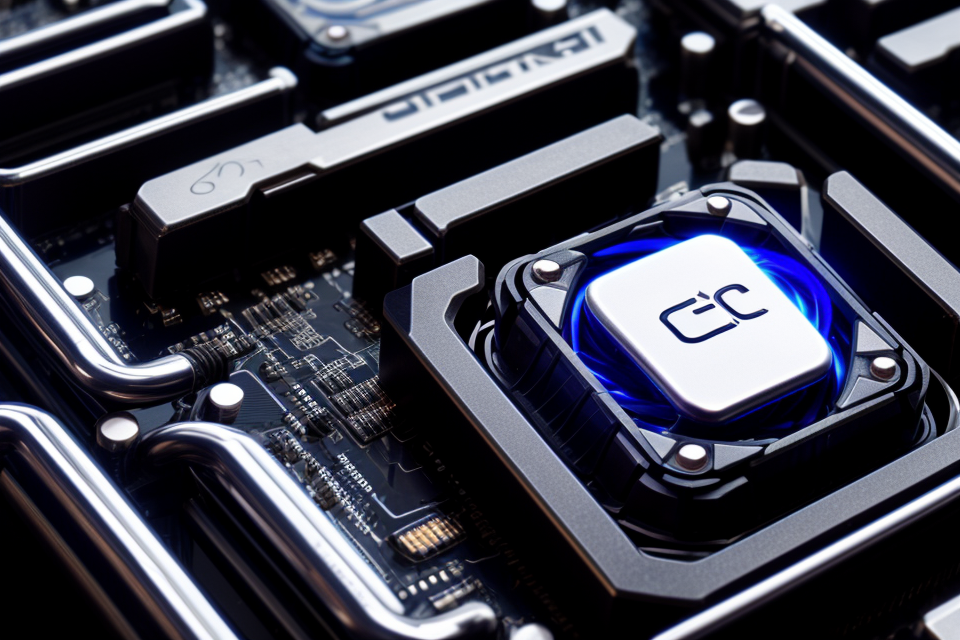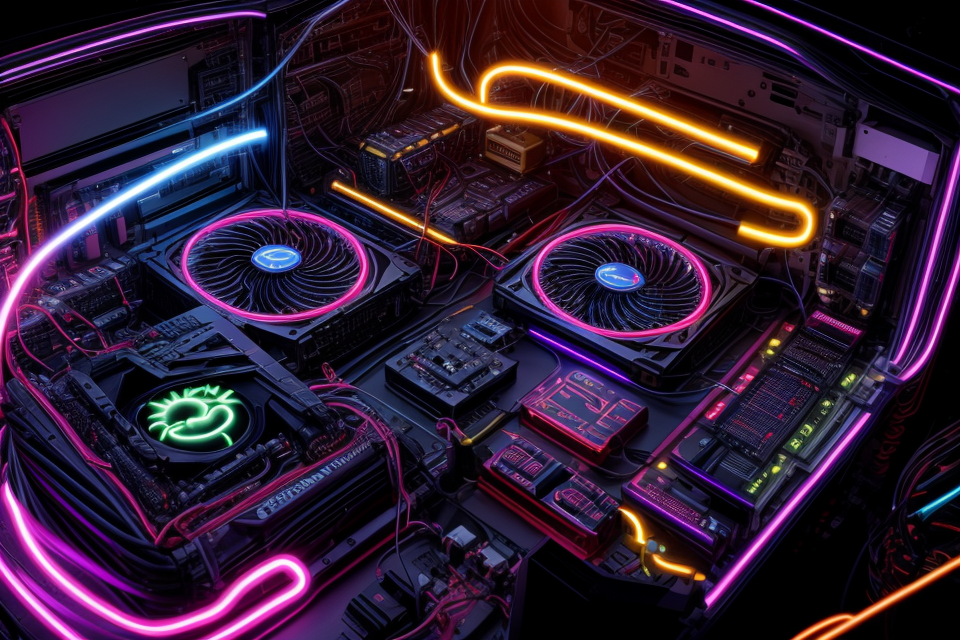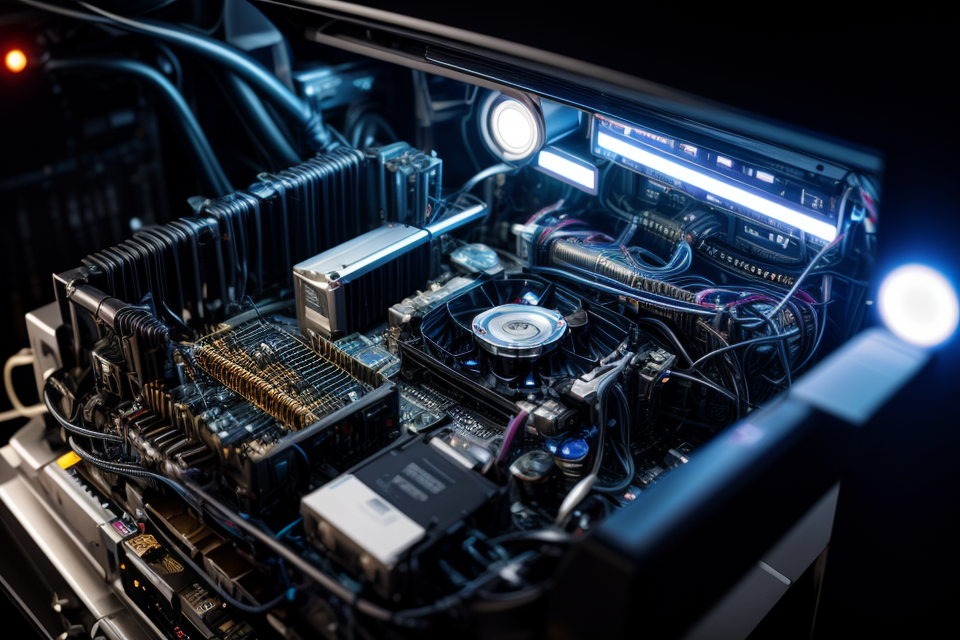
Are you looking to push your computer’s CPU to its limits? Look no further! Overclocking is the process of increasing the clock rate of a CPU beyond its standard specification, allowing for increased performance. But where can you check the overclocking options for your CPU? In this article, we’ll explore the different places to check for overclocking options and provide tips on how to maximize your CPU’s performance. Whether you’re a seasoned pro or a beginner, this article has something for everyone. So, let’s dive in and find out where to check overclocking options for your CPU!
Understanding Overclocking
What is overclocking?
Overclocking is the process of increasing the clock speed of a computer’s processor beyond its standard operating frequency. This is achieved by modifying the hardware or firmware settings of the CPU, allowing it to run at a higher speed than it was designed for. The goal of overclocking is to improve the performance of the CPU and the overall performance of the computer.
One of the main reasons to overclock is to increase the speed at which the CPU can execute instructions. This can lead to a significant boost in performance, particularly in tasks that are CPU-intensive such as gaming, video editing, and scientific simulations. Additionally, overclocking can also improve the responsiveness of the system and reduce the amount of time it takes to complete tasks.
It’s important to note that overclocking can be risky and can potentially damage the CPU or other components of the computer if not done properly. It’s recommended to have a good understanding of the risks involved and to take appropriate precautions before attempting to overclock a CPU.
How does overclocking work?
Overclocking is the process of increasing the clock speed of a computer’s processor, memory, or other components to improve their performance. The process involves modifying the settings in the computer’s BIOS or UEFI firmware to increase the clock speed beyond the manufacturer’s specifications.
CPU overclocking is the most common form of overclocking, which involves increasing the clock speed of the processor. This can significantly improve the performance of the CPU, allowing it to perform more calculations per second. However, it is important to note that overclocking can also increase the heat generated by the CPU, which can cause stability issues and potentially damage the processor if not done properly.
GPU overclocking involves increasing the clock speed of the graphics card, which can improve its performance and allow it to handle more demanding graphics workloads. Like CPU overclocking, GPU overclocking can also increase heat generation and stability issues if not done properly.
System overclocking involves increasing the clock speed of multiple components in the computer, including the CPU, memory, and graphics card. This can improve the overall performance of the system, but it also increases the risk of stability issues and heat-related problems.
Overall, overclocking can be a useful tool for improving the performance of a computer’s components, but it requires careful attention to detail and a thorough understanding of the risks involved. It is important to carefully monitor the system’s temperature and stability while overclocking and to adjust the settings as needed to avoid any potential damage to the components.
Benefits of Overclocking
Improved performance
Overclocking the CPU can significantly improve its performance in various tasks, such as gaming, video editing, and CPU-intensive tasks. This is achieved by increasing the clock speed of the CPU, which allows it to complete more instructions per second. As a result, the CPU can handle more demanding tasks, and the system becomes more responsive.
Overclocking can provide a noticeable performance boost in games, particularly in CPU-intensive titles like strategy games, simulations, and some RPGs. By overclocking the CPU, gamers can enjoy smoother frame rates, reduced lag, and faster load times. Additionally, overclocking can help reduce the need for a graphics card upgrade, allowing gamers to enjoy the game at higher resolutions and settings.
Overclocking can also be beneficial for video editing, as it can speed up the rendering process. Video editing software can take advantage of a faster CPU to process video files more quickly, allowing editors to work more efficiently. Overclocking can also improve the performance of other CPU-intensive tasks, such as 3D modeling, image editing, and scientific simulations.
It is important to note that overclocking can have some drawbacks, such as increased heat output and decreased lifespan of the CPU. However, when done correctly, overclocking can provide a significant performance boost for those who demand the highest levels of performance from their CPU.
Extending the lifespan of your hardware
Overclocking can be an effective way to extend the lifespan of your hardware by increasing its efficiency and reducing wear and tear. By overclocking your CPU, you can improve its performance and keep it running smoothly for longer periods of time. This can help you get more value out of your hardware investment and prolong the time before you need to upgrade.
Increased efficiency
Overclocking allows you to increase the clock speed of your CPU, which can result in faster processing times and improved performance. This increased efficiency can help you complete tasks more quickly and make your system more responsive. As a result, you may find that you can accomplish more in less time, making your hardware more valuable to you.
Reduced wear and tear
Overclocking can also help reduce wear and tear on your hardware. When your CPU is operating at its default clock speed, it may be subject to more strain and stress. However, by overclocking, you can reduce the number of times your CPU needs to work as hard to complete tasks. This can help reduce the amount of wear and tear on your hardware and prolong its lifespan.
In conclusion, overclocking can be a useful tool for extending the lifespan of your hardware by increasing its efficiency and reducing wear and tear. By taking advantage of overclocking options, you can make the most of your hardware investment and keep your system running smoothly for longer periods of time.
Checking Overclocking Options
Built-in overclocking tools
Overclocking, the process of increasing a computer’s processor clock speed beyond its standard operating frequency, can provide a significant performance boost. Many modern CPUs come with built-in overclocking tools that make it easy to achieve higher clock speeds. In this section, we will discuss the most popular built-in overclocking tools available for AMD, Intel, and NVIDIA processors.
AMD Overdrive
AMD Overdrive is a powerful overclocking tool that is included with all AMD processors. It provides a user-friendly interface that allows users to adjust various settings, including CPU clock speed, voltage, and power settings. Overdrive also includes a stress test feature that helps identify the maximum stable clock speed of the CPU.
Intel Extreme Tuning Utility (Intel XTU)
Intel Extreme Tuning Utility (Intel XTU) is a free overclocking tool that is included with all Intel processors. It provides a comprehensive set of tools for adjusting various settings, including CPU clock speed, voltage, and power settings. Intel XTU also includes a built-in benchmarking tool that can be used to stress test the CPU and identify its maximum stable clock speed.
NVIDIA GeForce Experience
NVIDIA GeForce Experience is a free overclocking tool that is included with all NVIDIA graphics cards. It provides a user-friendly interface that allows users to adjust various settings, including GPU clock speed, voltage, and power settings. GeForce Experience also includes a built-in benchmarking tool that can be used to stress test the GPU and identify its maximum stable clock speed.
Overall, these built-in overclocking tools provide an easy and effective way to achieve higher clock speeds and improve CPU performance. By using these tools, users can unlock their CPU’s full potential and experience a significant boost in performance.
Third-party overclocking software
Overclocking your CPU can significantly increase its performance, but doing it manually can be challenging and may lead to unstable results. Fortunately, there are third-party overclocking software tools available that can help you safely and easily overclock your CPU. In this section, we will explore three popular third-party overclocking software tools: MSI Afterburner, EVGA Precision X1, and AIDA64 Extreme.
MSI Afterburner
MSI Afterburner is a free overclocking software tool developed by MSI, a well-known motherboard manufacturer. It is compatible with most modern Intel and AMD CPUs and can be used to overclock both the CPU and GPU.
Some of the key features of MSI Afterburner include:
- Support for multiple GPUs: MSI Afterburner can be used to overclock multiple GPUs simultaneously, making it ideal for users with multiple graphics cards.
- Real-time monitoring: The software provides real-time monitoring of CPU and GPU temperatures, fan speeds, and power consumption.
- Customizable settings: MSI Afterburner allows users to customize various settings, including clock speeds, voltage levels, and fan speeds.
- Safety features: The software includes safety features such as automatic shutdown and overheating protection to prevent damage to your hardware.
EVGA Precision X1
EVGA Precision X1 is a paid overclocking software tool developed by EVGA, a well-known manufacturer of graphics cards. It is compatible with most modern Intel and AMD CPUs and can be used to overclock both the CPU and GPU.
Some of the key features of EVGA Precision X1 include:
- Customizable settings: EVGA Precision X1 allows users to customize various settings, including clock speeds, voltage levels, and fan speeds.
- Multi-GPU support: EVGA Precision X1 supports multi-GPU configurations, making it ideal for users with multiple graphics cards.
AIDA64 Extreme
AIDA64 Extreme is a paid overclocking software tool developed by FinalWire. It is compatible with most modern Intel and AMD CPUs and can be used to overclock both the CPU and memory.
Some of the key features of AIDA64 Extreme include:
- Customizable settings: AIDA64 Extreme allows users to customize various settings, including clock speeds, voltage levels, and memory timings.
- Real-time monitoring: The software provides real-time monitoring of CPU and memory temperatures, fan speeds, and power consumption.
- Diagnostic tools: AIDA64 Extreme includes a range of diagnostic tools, including stress testing and benchmarking, to help users optimize their system’s performance.
Custom overclocking settings
Modifying BIOS settings
Modifying BIOS settings is one of the most popular methods of custom overclocking. This method allows users to adjust the settings of their computer’s BIOS, which controls the system’s basic input/output functions. By modifying these settings, users can increase the clock speed of their CPU, which can lead to improved performance.
To modify BIOS settings, users must first enter the BIOS setup by pressing a specific key during the boot process. This key is usually displayed on the screen during the boot process and is typically the “Delete” or “F2” key. Once in the BIOS setup, users can navigate to the overclocking settings and adjust the clock speed of their CPU.
It is important to note that modifying BIOS settings can be risky and can potentially damage the computer if done incorrectly. Therefore, it is recommended that users only modify BIOS settings if they are familiar with the process and have experience with overclocking.
Manual overclocking
Manual overclocking is another popular method of custom overclocking. This method involves adjusting the clock speed of the CPU manually, rather than relying on the computer’s BIOS to control the clock speed.
To manually overclock a CPU, users must first check the motherboard manual to determine the maximum clock speed that the CPU can support. They then adjust the clock speed by increasing the frequency of the CPU’s clock signal.
Monitoring temperatures and voltage
Monitoring temperatures and voltage is an important aspect of custom overclocking. When the CPU is overclocked, it generates more heat and requires more voltage to operate. Therefore, it is important to monitor the temperature and voltage of the CPU to ensure that it does not overheat or malfunction.
Users can monitor the temperature and voltage of their CPU using special software, such as CPU-Z or HWMonitor. These programs provide real-time information about the CPU’s temperature, voltage, and other key metrics, allowing users to adjust their overclocking settings accordingly.
In conclusion, custom overclocking settings are an effective way to improve CPU performance. By modifying BIOS settings, manually overclocking the CPU, and monitoring temperatures and voltage, users can achieve significant improvements in performance without having to purchase expensive hardware upgrades. However, it is important to exercise caution when overclocking and to carefully monitor the CPU to ensure that it does not overheat or malfunction.
Ensuring stability
Overclocking safety measures
Overclocking can be a double-edged sword, as it can greatly increase performance but also increases the risk of hardware failure. As such, it is important to take certain safety measures before attempting to overclock your CPU. These safety measures include:
- Monitoring temperatures: Overclocking can cause your CPU to run hotter than normal, so it is important to monitor temperatures closely to avoid thermal throttling.
- Enabling power saving modes: Overclocking can also increase power consumption, so it is important to enable power saving modes to avoid wasting energy and to prevent your system from overheating.
- Disabling automatic overclocking: Some motherboards come with automatic overclocking features, which can be problematic if you want to manually adjust settings. Disabling these features can help ensure that you have full control over your CPU’s clock speed.
Stability testing
Once you have implemented the necessary safety measures, it is time to test the stability of your overclocked CPU. This can be done using a variety of benchmarking tools, such as SiSoftware Sandra or SuperPi. These tools can help you determine whether your CPU is stable at its new clock speed and can also help you identify any bottlenecks in your system.
It is important to run these tests for an extended period of time to ensure that your CPU remains stable over an extended period of time. This can help you identify any issues that may arise due to overclocking and can also help you fine-tune your settings for optimal performance.
Adjusting settings as needed
If you encounter any stability issues during testing, you may need to adjust your overclocking settings accordingly. This may involve reducing the clock speed, adjusting voltage settings, or implementing other modifications to ensure that your CPU remains stable at all times.
It is important to be patient and methodical when adjusting settings, as making too many changes too quickly can lead to instability and may even cause hardware damage. By taking a step-by-step approach and carefully monitoring your system’s performance, you can ensure that your CPU remains stable and reliable even when overclocked.
Overclocking Safety Tips
Understanding the risks
- Damage to hardware: Overclocking can cause irreversible damage to your CPU, motherboard, and other components if done improperly. Higher clock speeds generate more heat, which can cause thermal throttling and shorten the lifespan of your hardware.
- Unstable system crashes: Overclocking can make your system unstable, leading to crashes and system freezes. This can cause data loss and damage to your system, especially if you’re running critical applications or services.
- Decreased lifespan: Overclocking can decrease the lifespan of your hardware. Higher clock speeds generate more heat, which can cause thermal throttling and shorten the lifespan of your hardware. Additionally, overclocking can cause instability in the system, which can cause wear and tear on your hardware over time.
Proper cooling
Ensuring that your CPU is adequately cooled is essential when overclocking to prevent thermal throttling and damage to the processor. There are several options for improving cooling:
- CPU cooler upgrades: An aftermarket CPU cooler can provide better thermal performance than the stock cooler. Many coolers use larger heatsinks or more efficient heat pipes to dissipate heat more effectively.
- Fans and heatsinks: Adding more fans to your case or upgrading the stock heatsink with a larger, higher-quality heatsink can help improve airflow and reduce temperatures.
- Liquid cooling solutions: Liquid cooling systems use a liquid coolant to transfer heat away from the CPU. These systems often have better thermal performance than air coolers and can be quieter, making them a popular choice for overclockers.
When selecting a cooling solution, it’s important to consider the compatibility with your motherboard and case. Additionally, ensure that the cooler can provide enough clearance for the CPU socket and other components.
Monitoring temperatures and voltages
Overclocking your CPU can increase its performance, but it also raises the temperature and voltage levels. Therefore, it is essential to monitor these levels to ensure safe operation and prevent damage to your CPU.
Here are some ways to monitor temperatures and voltages when overclocking your CPU:
- Overclocking software: There are various software programs available that can help you monitor CPU temperatures and voltages while overclocking. These programs usually display real-time temperature and voltage readings, and some even have alarms to alert you if the temperature or voltage exceeds safe limits.
- Hardware monitoring tools: In addition to software, there are also hardware monitoring tools that can provide more accurate temperature and voltage readings. These tools often include sensors that are installed on the motherboard or CPU itself, providing real-time data on the CPU’s temperature and voltage levels.
- Staying within safe limits: It is crucial to stay within safe limits when overclocking your CPU. This means ensuring that the temperature and voltage levels do not exceed the manufacturer’s recommended limits. Exceeding these limits can cause permanent damage to your CPU and other components, resulting in reduced performance or even hardware failure.
Overall, monitoring temperatures and voltages is a critical aspect of overclocking your CPU safely. By using the right software and hardware tools and staying within safe limits, you can ensure that your CPU operates at its optimal performance level without causing any damage.
FAQs
1. What is overclocking?
Overclocking is the process of increasing the clock speed of a computer’s processor, memory or other components to increase their performance beyond their default specifications. This can provide a significant boost in speed and responsiveness, but it also carries some risks, such as instability, crashes, and reduced lifespan of the hardware.
2. How do I check if my CPU supports overclocking?
The ability to overclock a CPU depends on its specific model and manufacturer. To check if your CPU supports overclocking, you can refer to the documentation that came with your motherboard or CPU, or consult the manufacturer’s website. You can also use system information software, such as CPU-Z or HWiNFO, to check the CPU’s specifications and see if overclocking is supported.
3. How do I check the current clock speed of my CPU?
To check the current clock speed of your CPU, you can use system information software such as CPU-Z or HWiNFO. These programs will display the current clock speed, as well as other information about your CPU, such as the number of cores, clock speed, and manufacturer.
4. How do I adjust the clock speed of my CPU?
To adjust the clock speed of your CPU, you will need to enter the BIOS or UEFI settings of your motherboard. To do this, you will need to restart your computer and enter the BIOS or UEFI settings by pressing the key that appears on the screen during the startup process (usually DEL, F2, or F10). Once you are in the BIOS or UEFI settings, look for an option labeled “CPU Overclocking” or “Advanced CPU Settings” and adjust the clock speed to your desired level. Be sure to read the documentation for your motherboard carefully to ensure that you are adjusting the settings correctly and not causing any damage to your hardware.
5. Is it safe to overclock my CPU?
Overclocking can be safe if done correctly and with proper precautions. However, it can also be risky and may cause instability, crashes, or damage to your hardware if done incorrectly. Before attempting to overclock your CPU, it is important to research the specific requirements and limitations of your hardware, and to follow the manufacturer’s guidelines and recommendations. It is also a good idea to have a reliable backup of your important data in case something goes wrong.


